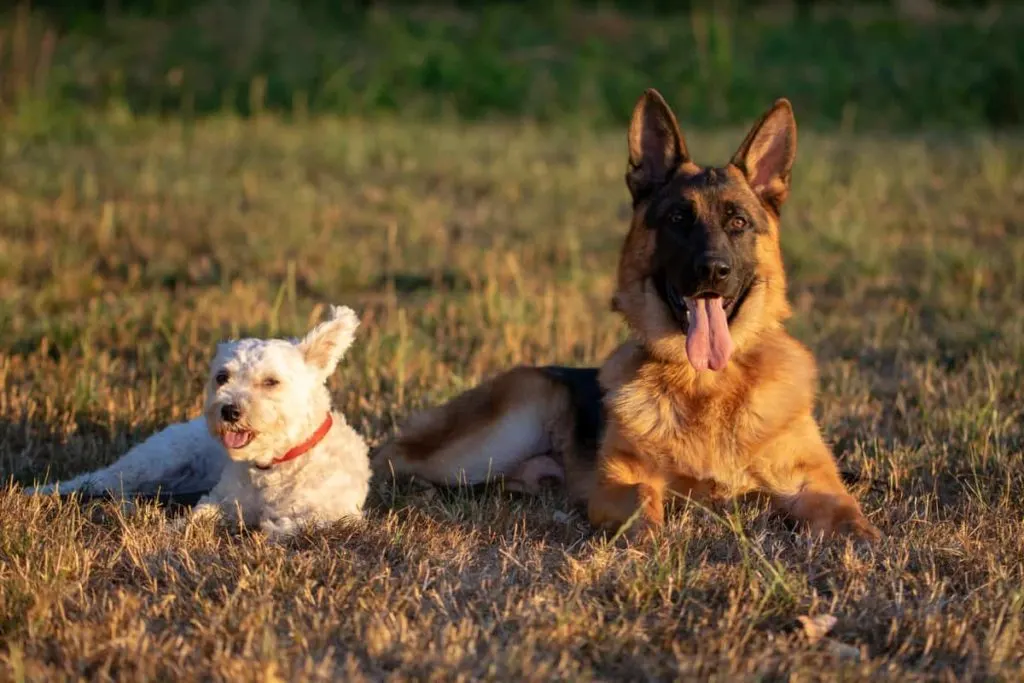
German Shepherds are well known for being loyal, “one person” dogs. They are fiercely loyal to their owners, and will often disregard or even show disdain towards people other than their owner. But what about other dogs – Are German Shepherds good with other dogs?
German Shepherds will approach unfamiliar dogs with caution. However, despite their intimidating size and demeanor, properly socialized German Shepherds typically get along very well with other dogs.
German Shepherds, just like people, have unique personalities. They all have their individual likes and dislikes, and they will often have their own favorite people, places, things – and their own favorite dogs as well.
In this article, we will take a close look how German Shepherds interact with other dogs, as well as give you guidance on how you can do your part to help your German Shepherd form safe and playful relationships with other dogs.
Click Here to Jump to a Section
Why Will a German Shepherd Behave Aggressively Towards Other Dogs?
To understand the behavior of a German Shepherd, it is essential that you get inside his psyche – you need to understand how he thinks.
Similar to a person, if something on the outside is aggravating a GSD, that bothersome something can most often be linked directly to something going on inside of the GSD’s mind.
Starting your inquiry from this perspective will give you the greatest chance of understanding why a GSD may be behaving aggressive towards another dog. This, in turn, will provide you with the greatest opportunity to resolve this behavior.
Let’s now take a closer look at some of the reasons why a German Shepherd may display aggression towards another dog.
Fear Due To a Lack of Proper Socialization
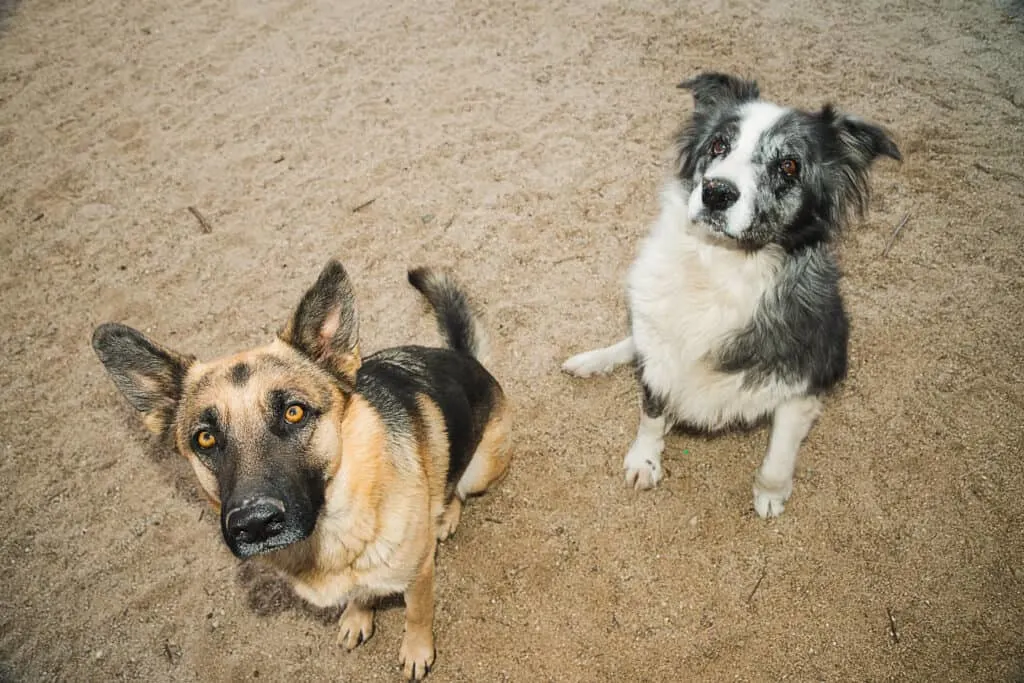
Properly socializing a German Shepherd while he is a puppy is one of the most, if not the most, important things that you can do to ensure that he remains calm and holds an even temper towards new situations.
These include new dogs, cats, people, or just about any animal for that matter.
Socializing a dog essentially means that you are taking the time to acclimate your dog to other people, animals, and situations. By spending time in new and unfamiliar situations and alongside new and unfamiliar people and animals, your dog begins to understand that these things are just a part of daily life.
The other side of familiarity is fear. Fear leads to aggression, which is what a dog will display towards other dogs if it has been properly socialized from a young age.
Unfortunately, many German Shepherd owners, especially first-time GSD owners, overlook this essential process.
It is very easy to get very wrapped up in loving your GSD puppy. The hours can just seem to pass by as if time doesn’t exist when you’re busy spending time playing all sorts of fun games with your GSD puppy.
While playtime is all well and good, and also an essential activity to engage in with your puppy, you need to strike a proper balance between play and training. And make no mistake, socialization is training.
While your puppy may seem very well adjusted when he is around you, the real test as to how well adjusted he actually is comes to light when he is exposed to other dogs. All too often, GSD owners are surprised when their dog lashes out at another dog for no apparent reason.
What they fail to see is that there is a definite reason – and that reason is a that they have neglected to take the time and effort to properly and effectively socialize their dog.
Properly socializing a German Shepherd puppy is fairly simple. Below, we have summarized a few simple things that you can do with your GSD in the interest of properly socializing him.
Take Your German Shepherd on Frequent Walks
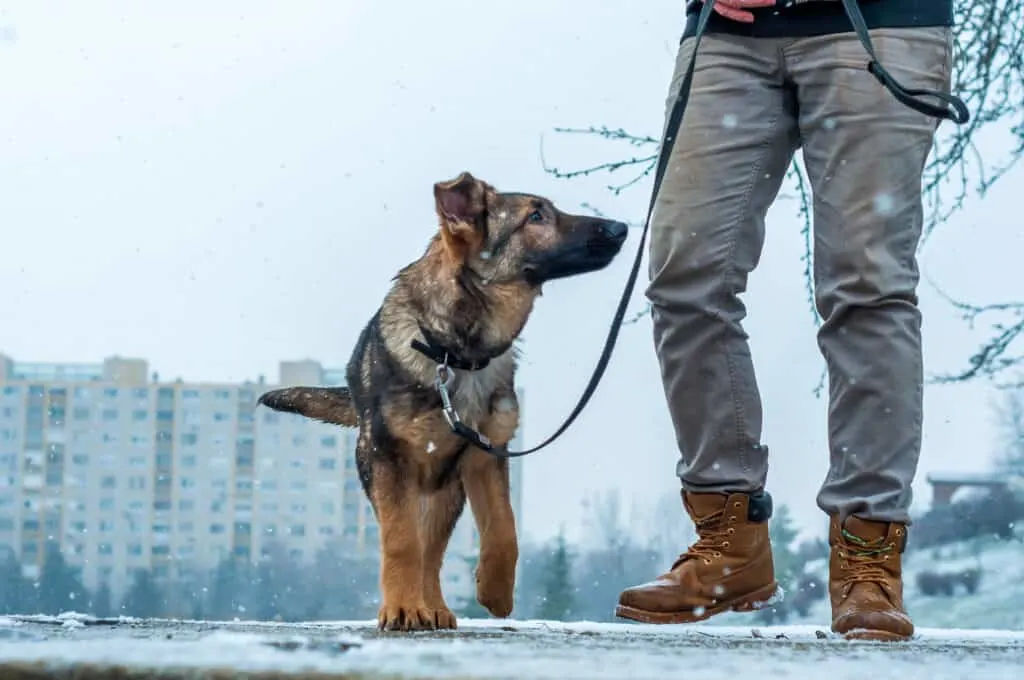
Walking your GSD is probably the easiest way to begin socializing him. For a GSD, a walk is far more than just exercise. As your GSD walks with you, he will be exposed to new sights, sounds, people, and animals.
The more that your GSD is exposed to what’s out there in the real world, as opposed to the comfort and safety of your home and yard, the more that he will acclimate to these things and view them as fun and intriguing rather than things to be fearful of.
In addition, walking is good exercise. And just like you, your GSD will feel more confident and at ease with himself after a good walk. He will have a higher self-esteem and an improved overall mood as well.
Take Your German Shepherd to a Dog Park
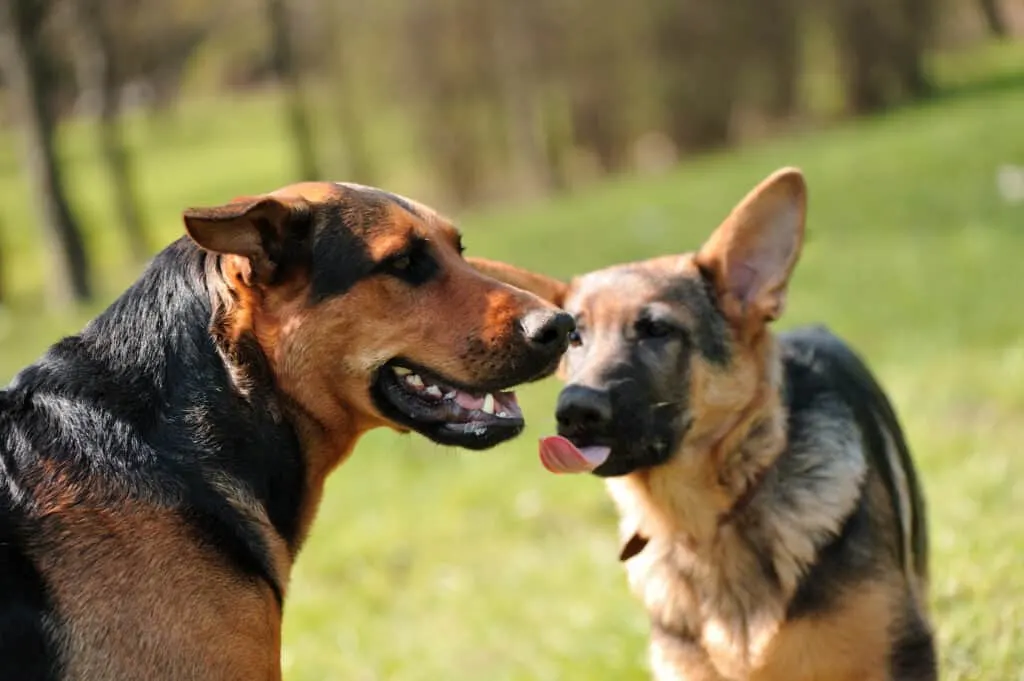
Provided that you have been making the effort to regularly take your GSD on walks, the next step is taking him to a dog park. A dog park is one of the best ways to really get your GSD used to being around other people and dogs.
It is important, however, that you do not just take your GSD to a park for the first time, let him off of his leash, and hope for the best. Doing this can potentially lead to some extremely undesirable results. Instead, take it slow.
By “take it slow,” we mean that when you first take your GSD to a dog park, stay on the periphery for a little while. Keep your GSD on his leash and walk him around the perimeter of the park.
Do not rush him, and allow him to take however long he wants to sniff around and observe the other dogs inside of the park.
Eventually, your dog will show a willingness on his own to want to venture inside amongst the other dogs. Still, do not wander inside with the other dogs as of yet.
Keep your dog on the outside of the fence, and allow him to sniff other dogs through the protection of the fence, and gauge his reaction from there.
Reward every positive interaction with a treat – even a “good boy” and a pat on the head will suffice. This will create a positive association between praise and friendly interaction with other dogs.
If your GSD reacts in a fearful or aggressive manner, then calmly move him away from the fence, and slowly work your way up to approaching it once again.
It is imperative that you remain patient during this process, and you may even find that you will have to go back to the same park several times before your GSD feels comfortable.
Once you feel confident that your dog reacts to other dogs in a positive and friendly way, then it is time for you to venture inside of the park, and eventually allow your GSD off of the leash.
If you have taken the time to make this transition a smooth one, your GSD will have a new favorite place to visit!
While a lack of proper socialization is a common reason why a German Shepherd may not get along well with other dogs, the aim of this article is to provide you with these reasons and an explanation of them, so we will not delve into the process of socialization any further in this article.
For a more comprehensive exploration of how to properly socialize a German Shepherd, we have written a great article for you right there – How To Socialize Your German Shepherd.
Dominance
Dominance in a German Shepherd is a behavior that can actually be traced back to their canine ancestors – wolves. Wolves base their societal and social interactions on a system of order.
This is commonly referred to as a “pecking order,” and at the top of that is the leader
However, the modern dog does not function within a society as its ancestors once did. They no longer have the ability to function as pack animals as they used to, and there is also no longer a necessity to do so.
Nowadays, a dog’s society and interactions within that society now consists of mostly people, rather than other dogs (or wolves). There is no longer the need to form packs for safety, and hunting is no longer a necessary part of daily life.
It’s easy to see the contrast of the world in which today’s dog is living compared to the world of his ancestors.
Inherently longing for a sense of order, and a dominant leader to guide the way, a German Shepherd will sometimes instinctively assume this role.
While assuming the role of leader is not a bad thing, it is important to distinguish a GSD that is displaying a dominant personality versus a GSD that is behaving aggressively due to dominance.
There are signs and cues that, when looked for, make it possible to distinguish between these two behaviors. If your GSD is displaying any of the following behaviors, then it likely that he is acting aggressively towards other dogs due to dominance:
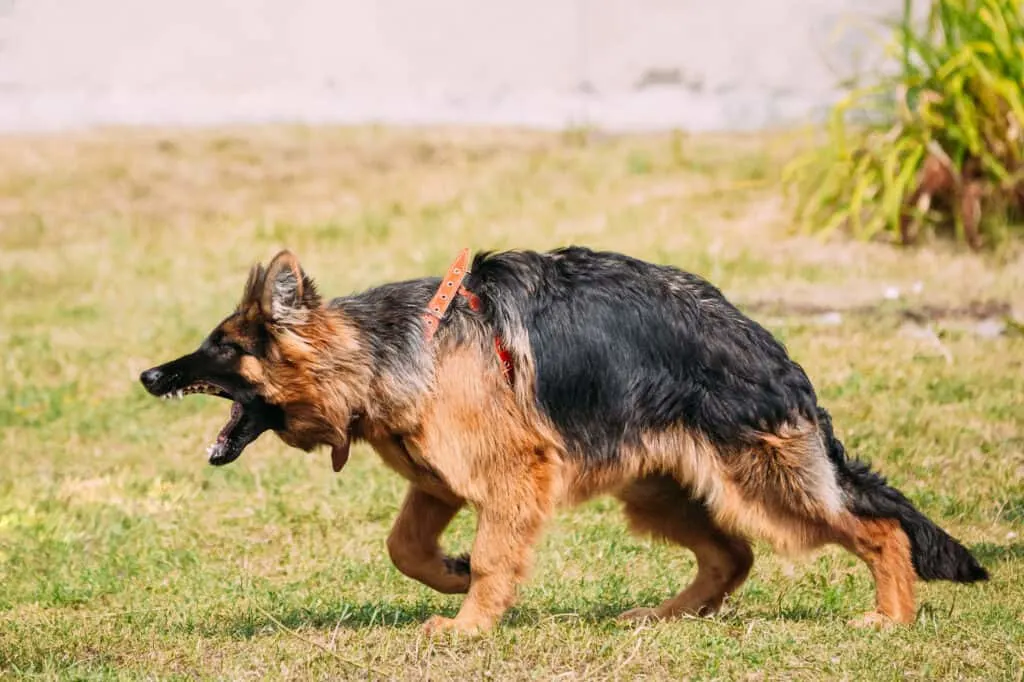
- Reacting aggressively, or challenging any person that looks them in the eyes or stands above them.
- Taking on a “guarding” posture when people or animals approach get too close to their food or toys.
- Growling or showing teeth at anyone who tries to remove food from them, or perhaps even nipping at or biting them.
- Growling or showing teeth when being verbally corrected for displaying an unacceptable behavior.
- Growling or showing teeth in response to being petted on a certain part of their body when there is no injury present.
If your GSD is displaying any of the above behaviors at home, you can be quite sure that he will also be aggressive towards other dogs.
If this is the case, it is wise to limit your GSD’s exposure to other dogs and swiftly begin a course of training and behavior modification.
Prior Negative Experiences
Similar to a person, a German Shepherd can experience a traumatic event that then stays with him and results in aggression towards other dogs. Let’s now take a look at a couple of real world examples of how this has played out in the lives of 2 different German Shepherds.
Example #1
I am presently working with a 5 year-old German Shepherd, Nikka, who was trained as a service dog. She was trained to alert her owner to high or low blood sugar levels, and to even break her owner’s fall in the event that her owner lost her balance.
Nikka did everything right, and she loved playing with just about any dog that would play with her. It was just in her kind and loving nature to do so, and it seemed that Nikka could do no wrong.
Unfortunately, one day Nikka had a run in with a small dog about 1/5 of her size during which the small dog actually bit Nikka in the eye. From that day forth, Nikka’s behavior changed in one very distinct way – she now viewed every other dog, big or small, as a threat, and became a viable danger to them.
As a result of this new found aggression stemming from the prior negative experience of being bitten by the smaller dog, Nikka could no longer be certified as a service dog, as service dogs need to be able to remain calm in any and all situations.
We are in the process of correcting Nikka’s behavior, and there is progress being made. But her situation exemplifies why a German Shepherd, through a prior negative experience, may behave aggressively towards other dogs.
Keep in mind that Nikka’s situation is but one example of any number of prior negative experiences that can cause negative or aggressive behavior by a German Shepherds towards other dogs.
Example #2
Consider Magnus. Magnus was a very kind-hearted 4 year-old GSD that got along famously with other people, and especially well with children.
But Magnus was aggressive towards all other dogs because he had what we humans refer to as an “inferiority complex.” An inferiority complex results in overcompensation or extremely asocial behavior.
Magnus behaved aggressively towards other dogs because, as a puppy, he felt as though he was bullied by other dogs. He was never bitten or physically harmed in any way by another dog, but he was barked at and lunged at as well. This was all that it took.
These experiences occurred because the dogs that showed aggression towards Magnus were not properly socialized by their owners.
When Magnus grew into an adult German Shepherd, he realized that he no longer had to feel any fear, as he was just as large or larger than the dogs that put fear into him.
However, this realization did not work to remove any of Magnus’s fear. The fear from the frightening experiences that he went through as a puppy stayed with him.
This this fear, combined with his impressive stature, made him the perfect candidate to show aggression towards other dogs.
I worked with Magnus, and his behavior was corrected, but he is another prime example of how a prior negative experience can work to fuel a German Shepherd not getting along with other dogs.
He is also an example of how neglecting to socialize your GSD, as described above, can turn into a vicious circle.
Anxiety
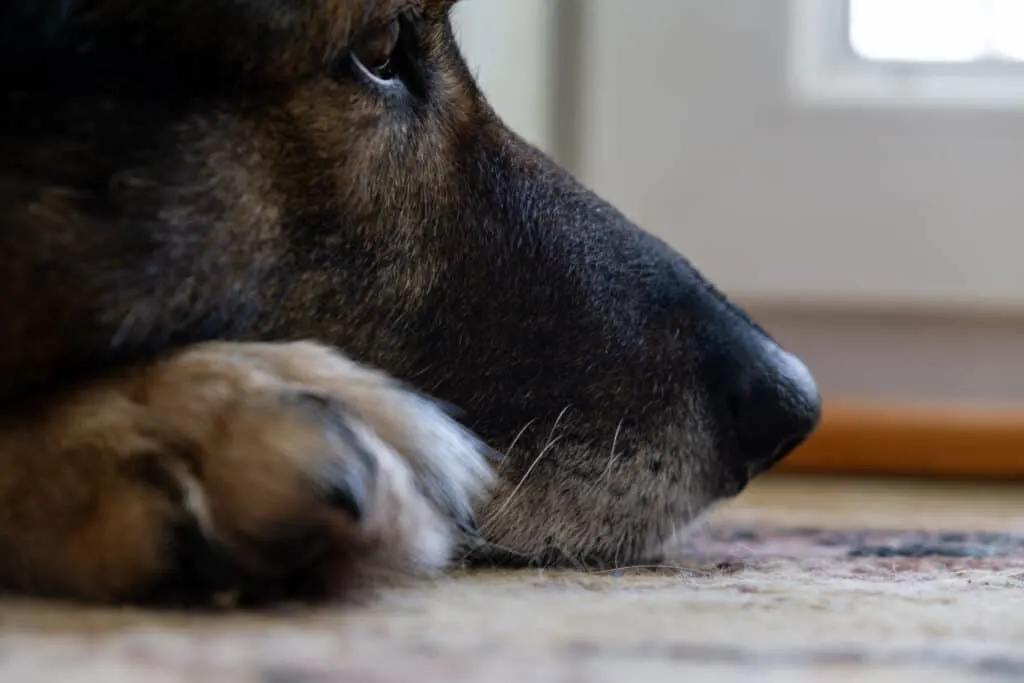
German Shepherds, like people, sometimes suffer from anxiety. The causes of anxiety in a GSD can range far and wide. However, one of the most common causes of anxiety in a GSD is a change in his environment.
A change in a German Shepherd’s environment can come about in many different forms. Below are a few examples of how this may present itself:
- Moving to a new home
- The addition of a new family member, such as a baby
- A new roommate moving in
- A roommate or family member moving out
- The death of a household family member
- The death of another pet – dog or cat, or any other animal that the GSD bonded with
- A change in a GSD’s walking schedule
- A change to a GSD’s feeding time
- A change to a GSD’s food
The above examples are by no means intended to be an exhaustive list. They are instead intended to provide you with some insight into how subtle a change of environment can be in order to trigger a German Shepherd to behave aggressively towards other dogs.
If you find that your GSD is behaving aggressively towards other dogs, then assess whether anything in his life has changed, no matter how small. It may be an easier fix than you think and may just require some time for adjustment.
However, if it is a not so subtle change in his environment that is causing your GSD to not get along with other dogs, then it is most likely that a course of training and behavior modification is in order.
Leash Aggression
Leash aggression in a peculiar phenomenon that may cause a GSD to behave aggressively towards other dogs.
You may find that your GSD is perfectly behaved around other dogs when he is off-leash, but once a leash is placed on him, he completely changes into what seems like a completely different dog.
Your GSD may bark, lung at, or even try to bite other dogs, but only when he is on a leash. Why is this?
Leash aggression is a combination of stress, frustration, and general emotional tension, as keeping a dog on a leash removes his ability to interact naturally with other dogs. Fortunately, with proper training intervention, this behavior can most often be resolved.
As we just stated, when a GSD is leashed, he is no longer able to meet and greet other dogs on his own terms. When meeting another dog naturally, a GSD will be very subtle, often interacting in ways that are largely undetectable to the untrained eye.
A certain body position, a particular look, or sniffing another dog in a specific way unique to your dog are no longer options when your GSD is leashed.
This can be incredibly frustrating to a GSD, so he will do anything that he can to get another dog’s attention. And given the constraining circumstance of being leashed, he has but a few options. Barking and lunging are simply the best that he can do.
A common result of this behavior is the GSD’s owner feeling frightened that their dog will bite another dog, and also feeling embarrassed about their dog’s behavior. As a consequence, they take their dog on fewer walks and rarely, if ever, let him off of the leash.
What this creates is a cycle that ensures a German Shepherd will never have healthy interactions with other dogs.
This is not a healthy thing, as dogs, just like people, need to have positive and healthy relationships with other dogs in the interest of their overall well-being.
The answer to resolving this problem goes back once again to proper socialization. It’s never too late to socialize a GSD, though older dogs will take more effort for any lasting change to take place.
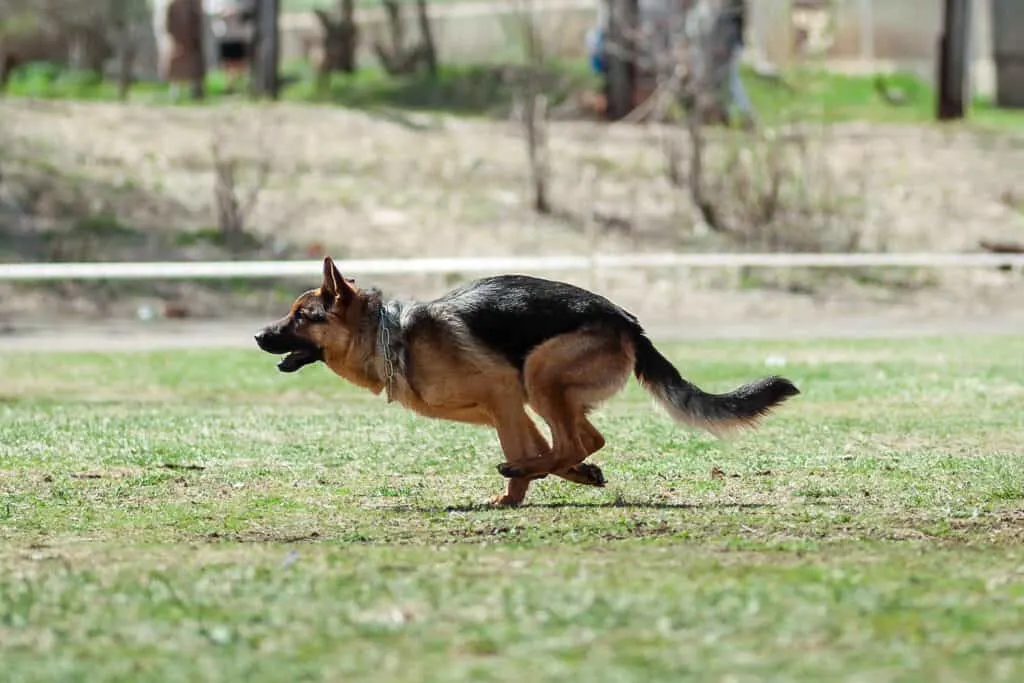
Although it may seem counter-intuitive, resolving leash aggression behavior is actually accomplished with your GSD being off of his leash when around other dogs.
Please keep in mind that this in no way means that you should just take your GSD off of his leash and hope for the best!
What this does mean, however, is that if your GSD’s behavior has progressed to this point, you will need to enlist the help of a professional trainer who is adept at reading the body language of both your GSD and the other dogs that he may be interacting with.
For a clear explanation of your your German Shepherd’s body language, we’ve got you covered in the article linked below. It will provide you with a comprehensive understanding of your GSD’s body language:
How to Read a German Shepherd’s Body Language
Again, we caution you to not take on attempting to change this behavior on your own. A professional trainer is in order.
In the meantime, however, there is something you can do which will serve as a distraction and reduce your GSD’s leash aggression.
Leash Aggression Reduction Training Exercise
When you walk your GSD, keep some small treats with you. Make sure that the treats are not large or high in calories, as you will be feeding your GSD a lot of them. Just follow these 3 simple steps.
- When you are walking your GSD on a leash and he sees another dog, call his name to get his attention.
- As soon as your GSD’s attention is turned toward you, give him a treat.
- Do this consistently – every single time your GSD even sees another dog, give him another treat.
By following the 3 simple steps above, you will effectively train your GSD to look at you as a reflex response when he sees another dog, as he knows that he will be rewarded for doing so.
Remember though that this is only a stop-gap measure for reducing leash aggression, and that you should enlist the help of a professional for off-leash training.
For some really helpful information about leash training your GSD, read our post “How To Stop Your German Shepherd from Pulling on the Leash.”
Your German Shepherd May Be Injured or Feeling Ill
When we humans are sick, we have the distinct capability to complain. Some of us may even take advantage of this form of attention seeking a little too much.
But our complaining serves as more than just inviting others to feel badly for us – it indicates to others that our health is in need of attention.
Your German Shepherd is not capable of complaining to you when he is sick.
Oftentimes, unless you know what you are looking for, the only obvious indication that you may get is if your GSD is sick is if he is vomiting or experiencing diarrhea.
However, it is important to understand that if a German Shepherd is feeling ill, even if you are unaware of his illness, that this may also affect his mood and interaction with other dogs.
If your GSD is displaying a new-found aggression toward other dogs, then it is possible that he may be sick or experiencing discomfort or pain that is causing this sudden change in behavior.
If this is the case with your GSD, then it is time for you to schedule an appointment with your veterinarian.
If he is actually sick and his aggressive behavior is due to this, then it is simply a matter of allowing your dog to feel better before you take him out to play with other dogs.
It is also wise, if your dog is sick, to refrain from playing much with him at home as well even with no other dogs present. Like you, the best way to overcome illness for a dog is rest, time, and medication if needed.
Possessiveness or Resource Guarding
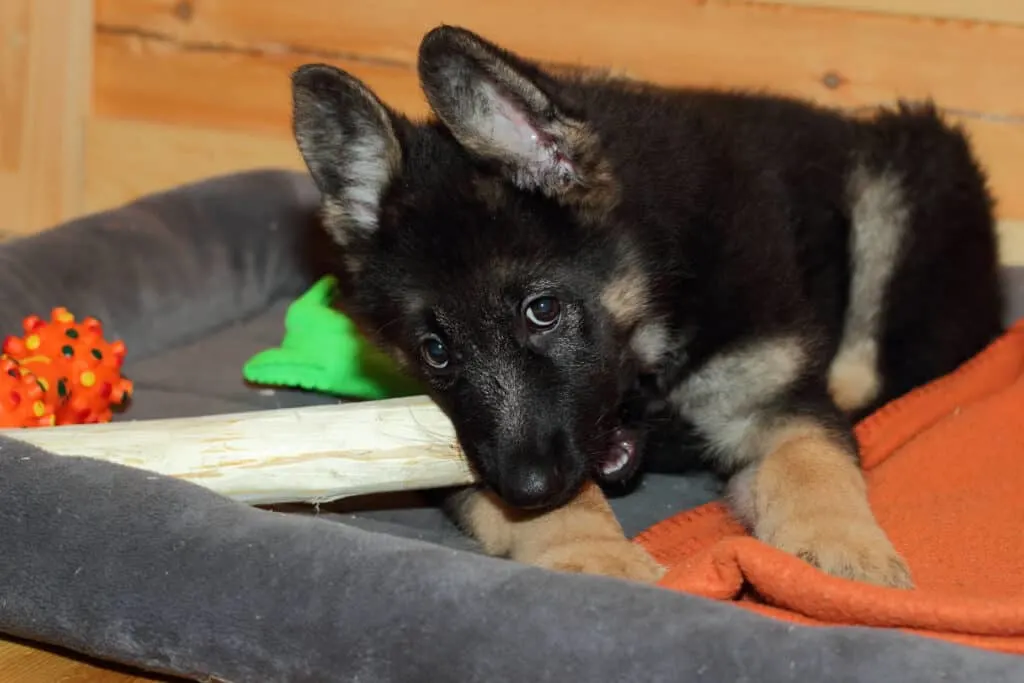
If exhibiting possessive guarding, also referred to as “resource guarding,” a German Shepherd may show aggression towards other dogs when he is in possession of an item that he views as valuable.
Resource guarding is also an aspect of dominance, but the behavior can be severe enough that it warrants further explanation. It most often occurs with food, bones, and toys. These are all things that your GSD may view as extremely valuable, if not priceless!
How aggressive a GSD may behave towards another dog while resource guarding is completely dependent on how valuable he views the object in his possession.
For example, your GSD may have a strong attachment to a particular toy, but not so much of an attachment towards another. Or perhaps he doesn’t care about his toys at all, but a bone to him is worth its weight in gold!
Regardless of the resource that your German Shepherd is guarding, and thus causing him to be aggressive towards other dogs, resolving this issue is relatively simple.
All that you really need to do is to just make sure that whatever the high-value object is, that you keep it away from your GSD when he is interacting with other dogs.
It is possible to train your GSD out of this behavior, but is it really worth it to you? Only you can answer that question.
Generally speaking, as long as your GSD’s negative behavior is directly linked to resource guarding behavior over a particular object, removing that object is most often the most simple way to approach the issue.
However, if your German Shepherd is fiercely protective of just about anything in his possession, you should consult with professional trainer or dog behaviorist.
It is important to note that a dog trainer and a dog behaviorist are two different things.
Here is a link that will make clear the difference between the two occupations to better help you decide on the kind of help that your GSD may need.
Your German Shepherd Is Not Spayed or Neutered
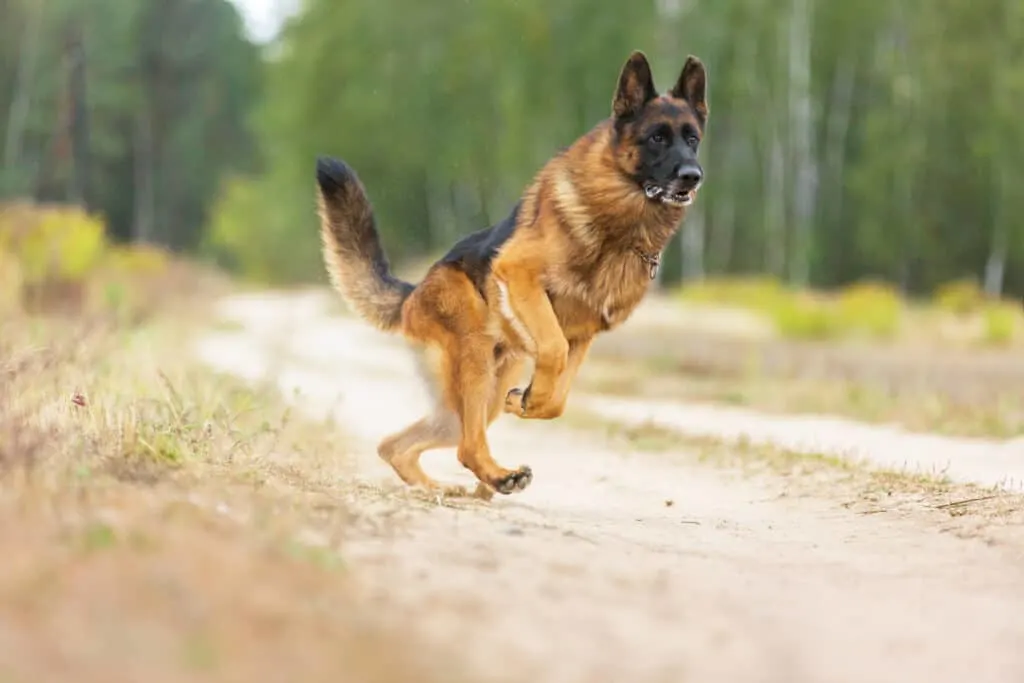
It is not uncommon for a GSD that is not spayed or neutered to act aggressively towards other dogs. This is because spaying and neutering eliminates reproductive hormones which often drive the aggressive behavior.
Female GSDs, when unspayed, often compete for the attention and breeding rights to a male GSD.
The way that this competing takes place is through fighting, and it does not require both females to be unspayed for a fight to ensue. A fight needs only one aggressor, and the other dog will then fight back in self-defense.
The same holds true for male GSDs. With their hormones running wild, they sometimes view any other dog in their presence as competition.
While this is a part of natural selection, or “survival of the fittest,” this is no longer necessary in a world where dogs are selectively bred and no longer have the need to fend for themselves.
However, the instinct for both males and females remains. The drive to compete for mating rights is a primal instinct that cannot be trained out of a German Shepherd. Fortunately, it can be curtailed through spaying or neutering.
While there are definite advantages to spaying or neutering your GSD, there are also some drawbacks as well as some effective alternatives.
To answer all of the questions that you may have, we’ve thoroughly covered the topic of spaying or neutering your German Shepherd for you in the article linked below:
Should You Spay or Neuter a German Shepherd? Pros and Cons
Final Thoughts
As we have explored in this article, your German Shepherd’s behavior around other dogs may be dependent on many different factors.
Sometimes the reason for your GSD’s behavior may be quite obvious, while other times it may require a little bit of investigating on your part, or even the help of a dog trainer or behaviorist.
However, it is very important to keep in mind that if your German Shepherd’s behavior towards other dogs is unacceptable, it is completely up to you to fix it.
The good new is that just about any behavioral problem that a German Shepherd may have can be corrected with the proper approach.
Also please keep in mind that the best way to fix a problem is to avoid it altogether.
You can do this by properly socializing your GSD when he is a puppy, and of course also by simply being a loving and attentive owner to you your German Shepherd!
